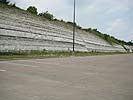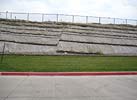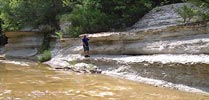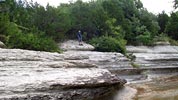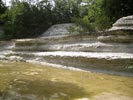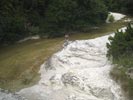|
The Geology of Texas - Vol. 1 - pages 444-451
BLACK PRAIRIE REGION - TYPICAL AUSTIN CHALK
From eastern Grayson County southwards, the Austin is in
general typical. It forms a wide, prominent and important outcrop, the
substratum of a part of the fertile black land belt (Black Prairie)
devoted largely to cotton raising. On it are located many important towns:
Sherman, McKinney, Dallas, Waxahachie, Midlothian, Waco, Temple, Austin
and San Antonio. The total chalk in eastern Grayson County is probably as
much as 1000 feet thick; near Dallas 700 feet; at Corsicana 425 feet; 480
feet in the Powell field and 440 feet in the Mexia-Richland area (969, p.
331); near Groesbeck, southern Limestone County, 350 feet; in Bell County
550-604 feet; in Milam County about 500 feet; in Williamson County,
325-342 feet; in Travis County, about 420 feet (275-400 in wells) ; in
Medina County, about 350 feet; in eastern Uvalde County, 350 feet; western
Uvalde County, about 350 feet [F. M. Getzendaner, personal communication].
Although the literature contains
records of 350 to 400 feet of Austin in Bexar County, many geologists now
consider that these thicknesses include some rocks of Taylor age. The
Austin chalk is stated to be 110 feet thick in eastern Bexar County [L. W.
MacNaughton, personal communication], and the 443 feet of Austin recorded
(888) in southwestern Bexar County is stated to include the Anacacho.
Likewise it is unknown how much, if any, of the upper part of the type
Austin chalk in Travis County should be separated from the true Austin.
These questions require extensive zonal work and a paleontological
redefinition of the type sections.
At the type locality the lower two-thirds of Austin
consists of irregular strata of variable thickness, from thin-bedded to
massive, and with often indefinite limits, generally alternately harder
and softer. They are composed of a gray-white chalky limestone in the
harder layers, and a dark blue or blackish marly limestone or limy marl
weathering dead white or light gray, and in texture unevenly flaky or
laminated. A few of the limestones are indurated, some are shelly. Some
contain much debris of oysters, inocerami and other shells. At certain
levels considerable glauconite, dispersed as small specks, occurs; the
formation contains imbedded balls, cylinders and irregular botryoidal
masses of pyrite with radiating internal structure; and locally veins,
seams and joint cracks filled with calcite. In youthful stream cuts
vertical cliffs of alternately projecting and receding strata occur; on
hillsides and upland prairies a rounded topography prevails. On many
patches of upland, headwater erosion is sufficiently rapid to strip the
outcrop of soil.
Generally harder and softer ledges are not topographically well expressed.
The upper part of the formation has considerable calcareous marl, in beds
up to 30 feet thick, and some very shelly marl (with Exogyra),
generally in beds 5 feet or less thick. Such a marl in northern Travis
County seems to be characterized by the presence of Exogyra tigrina Stephenson
and "Ostrea" centerensis Stephenson, and contains other
species listed below. A notable feature of this level is the presence of a
wide range and variety of Exogyra, probably referable to several
species.
The Austin consists of beds of
impure chalky limestone, containing 85 per Cent or more of calcium
carbonate, interstratified with beds of softer marl. It is usually of an
earthy texture, free from grit, and on fresh exposure softer, so
that it can be cut with a hand saw, but on exposure more indurated. In
thin slices the material shows calcite crystals, particles of amorphous
calcite, finely crystalline calcareous material, foraminiferan shells and
fragments, fragments of the prismatic layer of Inoceramus often in
great abundance, debris of pelecypods, gastropods, echinoids, and other
organic fragments. The material has the typical crystalline structure of
limestone. Some slices show abundant glauconite specks; some show a sparse
to medium amount of "spherical bodies" (see page 365) ; and some
show a finely crystalline texture almost devoid of organic material.
Typical analyses show calcium carbonate 82 per cent; silica and insoluble
silicates 11 per cent; ferric oxide and alumina 3 per cent; magnesia 1 per
cent.
The water-filled subterranean chalky limestone is
usually of a blackish-blue to bluish-gray color, as in most cores. The
air-dried material is generally glaring white and of a matte texture. The
dried marls may be more blackish or bluish. They weather mostly into
abrupt slopes capped by harder ledges. Some ledges become indurated and
crystalline; others, less crystalline, weather into irregular small
conchoidal flakes with an earthy fracture. The harder strata have an
irregular, ragged conchoidal fracture. Locally in the more massive layers,
there occurs a large conchoidal flaking, superficially resembling
exfoliation. On prolonged disintegration, the Austin weathers into a black
residual soil, characteristic of the Black Lands belt of east-central
Texas. Locally as near Pilot Knob, the Austin is metamorphosed, and occurs
as a porous, redeposited and recrystallized limestone in medium beds, soft
enough on fresh exposure to be sawed, nearly pure, and producing an
excellent building stone. The German Lutheran Church just north of the
Capitol at Austin is built of this stone. Formerly the ordinary Austin was
somewhat used as a building stone, but its softness, marly partings and
iron stain make it less desirable than other stones available in central
Texas.
The outcrop covers the southeastern one-fourth or more of Grayson
County. Marly lime is more prominent in the lower half of the formation,
and medium bedded to thick massive chalky limestone in the upper half. In
Dallas County the base of the chalk capping soft upper Eagle Ford shales,
clays and flags, forms the prominent west-facing White Rock escarpment
which proceeds southwards to the Brazos. It is well exposed in road cuts
and cement plants on the Fort Worth road about 5 miles west of Dallas.
In the quarry of the Texas Portland Cement Company 3 miles west of
Dallas, the base of the Austin chalk, just above the Eagle Ford contact,
is marked by a layer of phosphatic pebbles (1530, p. 148, and PL XXVII-A).
The basal part, 150 feet of the formation, consists of heavy-bedded,
massive chalk layers separated by thin shaly layers, the most resistant
beds being contained in the basalmost 50 feet (1454, p. 19). The basal
part contains an abundance of nodular, spherical or cylindrical masses of
pyrite.
The middle part, about 250 feet thick, has fewer
massive layers, and is characterized by thick, and often indurated shaly
layers which show a fine lamination. This part does not show in stream
cuts as marked expression of projecting and receding layers as does the
basal part. The uppermost part contains more shaly limestone and less
chalk. The colors are predominantly blue and yellow. Some sandy strata
occur. At the Austin-Taylor boundary, there is a sharp transition from
massive flaggy chalk (containing "large ammonites,' most of them Parapuzosia)
to gray shale, some of it calcareous.
In the Waco region the basal chalk is well exposed
in Cameron Park. Here it consists of medium to thick massively bedded
strata with some alternating receding ledges. By undercutting of Bosque
River large blocks fall down the slopes and disintegrate. Flaking and
exfoliation are extensive. In the cuts of Brazos River across the Austin
chalk outcrop, considerable small scale faulting, with the development of
V- and A-shaped grabens and horsts, is present. Such local faulting occurs
in White Rock Creek near the Harrington well.
The base of the chalk, and locally the hard Eagle Ford flags, form
the crest of the west-facing Bosque escarpment across McLennan
County. The Bosque is deflected parallel to this scarp and follows it
northward to the point where the Brazos cuts through the scarp. Along the
scarp, there is considerable faulting in disconnected lines. The medial
part of the chalk consists of medium bedded chalky limestone softer marly
layers, weathering white. The Austin-Taylor contact occurs in and near the
Baylor University Campus. Here the topmost chalk stratum is a massive
chalky limestone containing Inoceramus undulato-plicatus and other
species, and is followed with a sharp lithological break by blue-black
Taylor shale. Stephenson considers that about the upper 250 feet of chalk
is here absent by subsequent erosion. The top of the chalk occurs in
several creeks just east of the Waco-Austin highway. In these creeks Dr.
Pace has demonstrated a persistent line of faulting, possibly the eastern
limit of the Balcones fault zone in this area.
Southward from Waco, the typical hard Austin chalk is overlain by a
chalk marl of variable thickness, generally referred to the Taylor because
of its foraminifera. In or near the base of this marl at many localities,
large ammonites of the genera Parapachydiscus and Parapuzosia occur,
and their zone of abundance marks approximately the top of the Austin
chalk. Unfortunately their exact zonation has not yet been published. They
occur in several localities southwest of Robinson and Rosenthal, and east
of Temple, west of Holland in the branches of Darr's Creek, north of
Austin in Big and Little Walnut creeks, on the Rio Grande at Tequesquite
Creek between Del Rio and Eagle Pass, and near San Carlos, Coahuila. Some
of these "cart-wheel" species reach large size; two of them have
been described from Tequesquite Creek by Scott and Moore. The eastern
border of the chalk is exposed near Garland, east of a line between Waco
and Eddy, in Deer Creek, in northern Bell county near Little Flock Church
east of Temple, in various creeks west of Holland, in Brushy Creek south
of Hutto, and in various creeks in Travis County.
In San Antonio the excavations in Brackenridge Park represent the
Austin chalk at levels between 100 and 150 feet above the base. The rock
is evenly bedded in strata of from six inches to several feet in
thickness. It is light gray, tinged with yellow. Oxidized pyrite nodules
are present. Near the base of the quarry, a layer rich in Gryphaea shells
occurs. In this county the upper 200 feet of the Austin is a soft bluish
calcareous clay or mud. In these beds Stephenson found Scaphites sp.,
Placenticeras sp., and a large Baculites.
The Austin in Medina County (992, pp. 46-48) consists of
alternations of soft chalky limestones and marls, argillaceous shales, or
clays. Near the top the formation is mostly chalky limestone. The basal
half of the Austin as far west as Hondo River contains ledges which are
highly glauconitic. The upper part especially has vertical cylindrical
concretions of pyrite with radiating structure. The basal 75 feet is quite
highly indurated and lithologically somewhat resembles the Buda, but lacks
the calcite veins characteristic of that formation. At a level about 275
above the base there is a layer of Gryphaea aucella shells, about 4
to 5 feet thick, which persists across Medina and Bexar counties, and is
possibly the same as the prominent Gryphaea layer above the middle
of the formation at Austin.
In the Uvalde area the Austin consists of soft, white and yellow
chalky limestone and limy marl alternating. Two large exposures are on the
east side of Nueces River opposite Soldiers Camp Spring, where the upper
150 feet is exposed; and a basal 200 feet in the high bluff on the west
side of the Nueces between the Southern Pacific Railroad and the West
Nueces. Gryphaea aucella Roemer, Inoceramus aff. digitatus
Sowerby, and Mortoniceras texanum (Roemer) are recorded from
the Austin in this area.
BURDITT MARL
Nomenclature.—Hill included this chalk marl with the
Austin chalk, and stated that the top is transitional to the Taylor. Taff
(1574, p. 353) segregated the upper marly lime zone of the Austin chalk,
and considered it lithologically transitional to the Taylor marl. This
chalk marl is here called Burditt, from Burditt School, Travis County, and
the type locality is along Little Walnut Creek downstream from the
Austin-Cameron road. |
